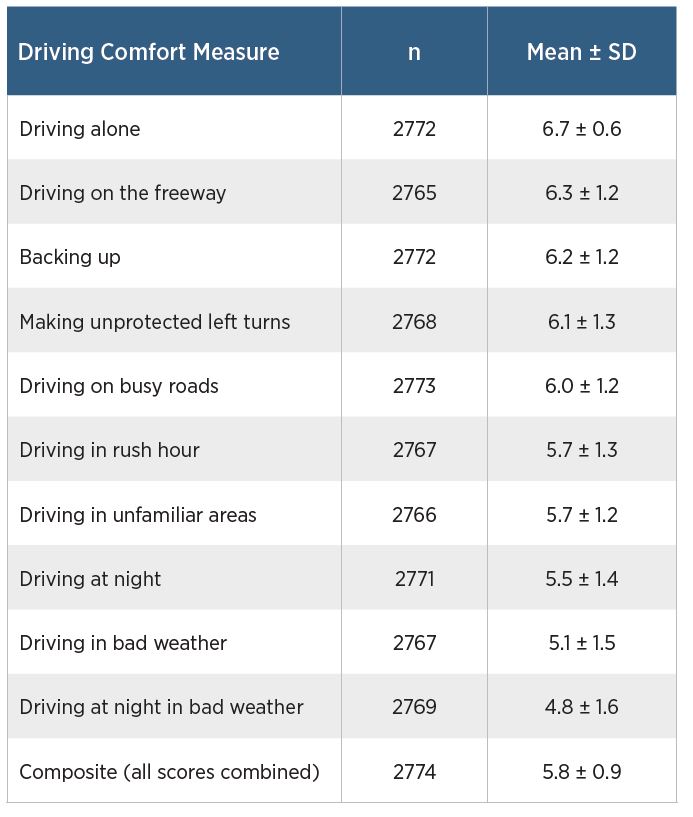
Predictors of Rapid Deceleration Events among Older Drivers: AAA LongROAD Study
This brief examines the relationship between hard braking events (known as rapid deceleration events (RDEs)) and safety-related outcome measures such as near crashes and declining functional abilities.
February 2020
Suggested Citation
Abstract
Introduction
Research over the past two decades has focused on developing effective countermeasures to reduce the frequency and severity of crashes involving older drivers. Recent studies in which vehicle acceleration data were recorded have explored the relationship between hard braking events (known as rapid deceleration events (RDEs)) and safety-related outcome measures such as near crashes and declining functional abilities. This relationship has found that RDEs may be related to driving safety. To this end, the relationship between crash risk and RDEs among older drivers has been examined as a surrogate measure of unsafe driving. Two previous studies recently examined factors related to RDEs in naturalistic driving among cohorts of older adults. They yielded different results, although they also used different thresholds for rapid deceleration. The lower threshold RDEs of .35 g (RDE35) may be more indicative of risky driving by drivers who have high functional abilities (as found by Keay et al., 2013). In contrast, the high threshold RDEs (.75 g, RDE75) may be indicative of driving errors or lapses that are more common among those with fewer functional abilities (as found by Chevalier et al., 2017). This new examination continued the research by examining the relationship among RDE rates, demographics, visual abilities, cognitive abilities and perceived driving comfort. Findings indicate that RDE rates may have value as a surrogate safety measure, in conjunction with other factors, including sex and the driving environment. Further research is needed to better understand and define an appropriate threshold for determining a RDE and its value as a surrogate measure of crash risk.
Key Findings

Methodology
The study utilized data from 2,774 participants from the multi-site AAA Longitudinal Research on Aging Drivers (LongROAD) study. Objective visual and cognitive data were collected at baseline and global positioning system (GPS) data were collected over one year of driving after baseline. Three aspects of objective visual ability were analyzed: (1) acuity; (2) contrast sensitivity; and (3) overall visuospatial perception ability. Several tests of cognitive ability were also analyzed: (1) verbal fluency (retrieval fluency test); (2) executive function (trail making A and B); (3) visuospatial ability (clock drawing test); (4) episodic/working memory (immediate and delayed word recall); and (5) attention and psychomotor speed (digit symbol substitution test). Simple and choice reaction times (Deary-Liewald reaction time task) were also analyzed in the cognitive test. A datalogger device was installed in participant’s vehicles, which recorded GPS information whenever the vehicle ignition was turned on. Based on previous studies with older drivers (Chevalier et al. 2017; Keay et al. 2013) RDEs were calculated from longitudinal acceleration derived from vehicle speed from the GPS data. Counts of all RDEs with a peak value of either .35 g (RDE35) or more, or .75 g or more (RDE75), and a starting speed greater than 4.47 m/s (10 mph) were recorded for each month and each participant. Driving comfort was collected from items assessing self-reported level of comfort on a 7-point scale (1 being not at all comfortable and 7 being completely comfortable) in 10 scenarios.
Results
This paper investigated factors related to RDE rates among a large cohort of older drivers using two empirically-based thresholds for an RDE—.35 g and .75 g. Unlike Chevalier et al. (2017), the present study found very few RDEs when the threshold was defined as .75 g or greater deceleration. While the reason for this difference in the rates of RDE75 is unknown, it is possible that participants in the study by Chevalier et al. had lower functional abilities that were more likely to adversely affect driving behaviors. The Chevalier sample was considerably older and drove significantly fewer miles than AAA LongROAD participants. Unlike both Chevalier et al. (2017) and Keay et al. (2013), none of the visual ability measures and few of the cognitive measures were significantly related to RDE rates. One possible explanation for this difference is that the LongROAD participants at baseline were very healthy and high functioning compared to the older driver groups used in the other studies. In conclusion, RDE rates as defined by a longitudinal deceleration of .35 g or greater may have value as a surrogate safety measure, especially in conjunction with many other factors including driver sex and the driving environment. Other ability-related covariates may also be significantly related to RDE35s. However, the lack of variance in these measures in the current study due to relatively healthy and high functioning sample did not allow us to find these effects. Results of this study suggest that the selection of a specific threshold for RDEs has important implications for which factors may be associated with this driving behavior, and what the safety outcomes might be. Future research is needed that examines the full range of RDE thresholds to better understand the implications of rapid deceleration as a safety surrogate. AAA LongROAD data will be instrumental in supporting this research area as it is one of the largest cohorts of older drivers. A key takeaway note for future researchers and practitioners is recognizing that this new generation of aging drivers, largely the baby boomers, are healthy and maintaining their driving.
Suggested Citation